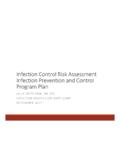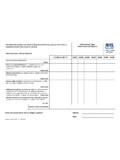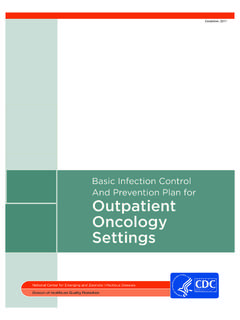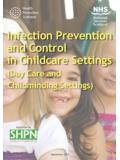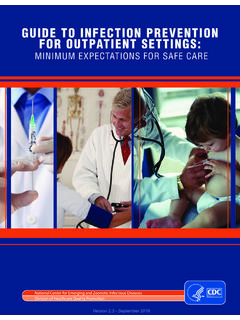Transcription of Basic Elements of a LTC Infection Control Program
1 Basic Elements of a LTC Infection Control Program Teri Lee Dyke RN, MSN, CIC April 10, 2012 Today s Topics Basic Elements of an Infection Control Program Long Term Care: F441 the facility must establish and maintain an Infection Control Program designed to provide a safe, sanitary and comfortable environment and to help prevent the development and transmission of disease and Infection Surveillance TB Control Programs Transmission-based Precautions Antibiotic Resistant Organisms New Updated Resources Disaster Preparedness Survey techniques New Hire Orientation All Employees Staff Specific Ongoing Regulatory Mandate Task-specific Facility-determined Pre-placement evaluation Routine screening Work restrictions Occupational exposure management Personal hygiene Blood Stream.
2 Eyes, Ears Gastrointestinal & Genitourinary Tract Skin; Respiratory Tract; Central Nervous System - - - Dental Service Dietary Services Equipment: Cleaning Disinfection/Sterilization Environmental Cleaning & Pest Management Emergency preparedness Facility operations; air, water construction/renovation Laboratory/Pathology Linen/Laundry Personal care services Rehabilitation Services Service animals; Pet therapy Waste management Employee Health Prevention & Control Body System Review Leadership Education Surveillance/ Performance Measurement MI MODEL : Infection PREVENTION & Control Program MSIC Revised 2005 Scope: processes & outcomes Patient: Community & Healthcare- Associated Infection Personnel: Health & Injury Prevention Environment of Care (EOC) Outbreak and Sentinel Events Philosophy-Authority-Responsibility Patient & Personnel Safety Culture Oversight.
3 Function and Committees Performance Improvement Regulatory Compliance Community Standards of Care Antimicrobial use Asepsis Patient Care Plan Continuum of care Hand Hygiene Immunization Isolation Precautions Basic Elements of an Infection Control Program Leadership Philosophy Authority Responsibility Over-site: Function and Committee Performance Improvement Regulatory Compliance/Community Standards of Care Basic Elements of an Infection Control Program Surveillance Scope Patient care processes Patient outcomes Employee Outbreak/Sentinel Event Management Environment/Physical Plant Basic Elements of an Infection Control Program Prevention and Control Clinical Antimicrobial usage Aseptic technique Patient assessment and Care Plan Continuum of care Hand washing Immunization Standard Precautions and Isolation Precautions Basic Elements of an Infection Control Program Prevention and Control Body System Bloodstream Site and technique of
4 Insertion Type of catheter material used Hand hygiene and aseptic technique Skin antisepsis Catheter site care Catheter securement Use of antimicrobial/antiseptic impregnated catheters Basic Elements of an Infection Control Program Prevention and Control - Body Systems GU Continence and incontinence management Urinary catheter management-restrict use Cleaning and disinfection of vaginal speculums Basic Elements of an Infection Control Program Prevention and Control - Body Systems Skin Skin integrity assessment Pressure ulcer prevention and management Management of artificial openings Pediculosis (Lice) identification treatment and Control Scabies identification treatment and Control BED BUGS Management of herpes infections , cellulitus, and burns Hair removal Body piercing and tattoos Basic Elements of an Infection Control Program Respiratory Inhalation therapy IPPB C-Pap Bi-Pap Oxygen administration Medication administration Suctioning Tracheostomy care Ventilators Use and cleaning of respiratory equipment ( humidifiers, nebulizers, breathing circuits, peak flow meters.)
5 Suction equipment TB Skin test Swallow evaluation Basic Elements of an Infection Control Program Prevention and Control - Body Systems GI Nutrition and hydration Enteral feedings Bowel management Management and treatment of patients with diarrhea and or emesis Management of patients with Clostridium difficile Cleaning and disinfection of endoscopes Basic Elements of an Infection Control Program Prevention and Control - Body Systems Ears, Eyes, Nose, Mouth and Throat Oral hygiene Ocular hygiene Ear hygiene Speculum cleaning and disinfection Hearing aide cleaning and maintenance Basic Elements of an Infection Control Program Prevention and Control - Body Systems CNS Spinal Tap Management and treatment of a patient with known or suspected bacterial meningitis Management of patient with prion disease Basic Elements of an Infection Control Program Prevention and Control - Body Systems Reproductive Conjugal visitation Speculum cleaning and disinfection Screening for sexually transmitted diseases Basic Elements of an Infection Control Program Prevention and Control Support
6 Services Dental Services Disinfection and sterilization Basic Elements of an Infection Control Program Prevention and Control Support Services Sterilization, Disinfection and Cleaning Whirlpools bathing unit Thermometers Reusable instruments/equipment Reuse and reprocessing of items labeled for single-use Storage of clean and sterile items Use and monitoring of sterile processing Use and monitoring of High-level disinfection pasteurization Basic Elements of an Infection Control Program Prevention and Control Support Services Beauty and barber shop, hair, and nails Cleaning and disinfection of combs Brushes, razors, etc Linen management Nail care Basic Elements of an Infection Control Program Prevention and Control Support Services Linen/Laundry Clean and soiled linen management for facility and personal Handling Storage Transport Soiled linen processing If vendor used.
7 Monitor Basic Elements of an Infection Control Program Prevention and Control Support Services Laboratory/Pathology Services Specimen collection, storage and transport Reporting of abnormal results Reporting of antimicrobial sensitivity Antibiograms Use of waived testing Quality controls for testing Basic Elements of an Infection Control Program Prevention and Control Support Services Pest Management Evidence of an integrated pest management plan Construction and renovation Infection Control approval Barrier/site evaluation Basic Elements of an Infection Control Program Prevention and Control Support Services Animals, birds, fish and plants Screening for health/temperament Screening residents for allergies and compatibility Caring for pets while in facility, (contracted?)
8 Include protocols) Bite protocol, domestic and wild Basic Elements of an Infection Control Program Prevention and Control Support Services Podiatry Cleaning and disinfection of equipment Radiology Cleaning and disinfection of equipment Rehab services: occupational, physical and speech Cleaning and disinfection of equipment and whirlpools Wound management: debridement and wound care Basic Elements of an Infection Control Program Prevention and Control Support Services Waste management Medical waste management plan Waste separation Waste handing and transport Waste disposal Documentation Basic Elements of an Infection Control Program Prevention and Control Support Services Water supply Have a Disaster Plan for emergency water supply Disaster planning Evacuation Stockpile monitoring Alternate plans for hemodialysis Basic Elements of an Infection Control Program Employee Health- inclusive of full-time, part-time, contingent/contracted employees.
9 Students and volunteers Bloodborne pathogens Program Job descriptions include: Job essential job function Job-specific hazard exposure assessment Personal Protective Equipment requirement Policies for contracted employees and students to delineate facility responsibility Basic Elements of an Infection Control Program Employee Health- Baseline health assessment Immunization for or documentation of immunity for measles, mumps, rubella, chickenpox, tetanus, hepatitis Influenza vaccination Program Screening for latent TB, Mantoux method of TB skin testing using PPD two step method vs. quantiferon serology test TST among BCG recipients Basic Elements of an Infection Control Program Employee Health- Annual/periodic Screening Health assessment Immunizations TB evaluation (TST, questionnaire) Basic Elements of an Infection Control Program Employee Health- Work restrictions Work restrictions related to communicable disease Work-related exposure and return to work policies Basic Elements of an Infection Control Program Employee Health- Post-exposure Management Identification, reporting, evaluation, and management of an exposure ( BBP, TB, meningitis, scabies)
10 Treatment, consents and processes Basic Elements of an Infection Control Program Employee Health Personal hygiene Dress code Personal hygiene Hand hygiene Artificial nails Basic Elements of an Infection Control Program Education Employee upon hire Hand hygiene Dress code, personal hygiene Standard/Isolation precautions Immunizations Illness reporting/work restriction Exposure Control plans Bloodborne infectious diseases Tuberculosis Control plan Aseptic technique Basic Elements of an Infection Control Program Education Employee (ongoing, annual, periodic) Change in regulatory standard Change in policy Non-compliance Patient, families, and visitors Hand hygiene Infection prevention Isolation procedures Procedure specific Antimicrobial resistance reduction Surveillance Methods- Standardized, Definitions, Denominators Whole-house limitations Targeted, point prevalence Device related Combination Based on high risk, high volume probl










